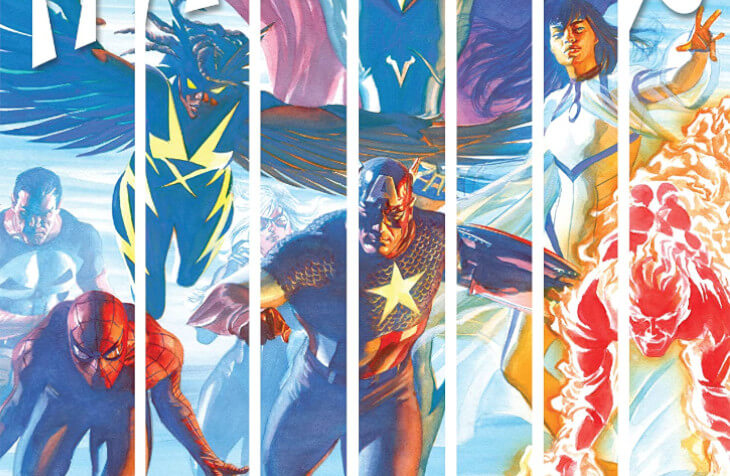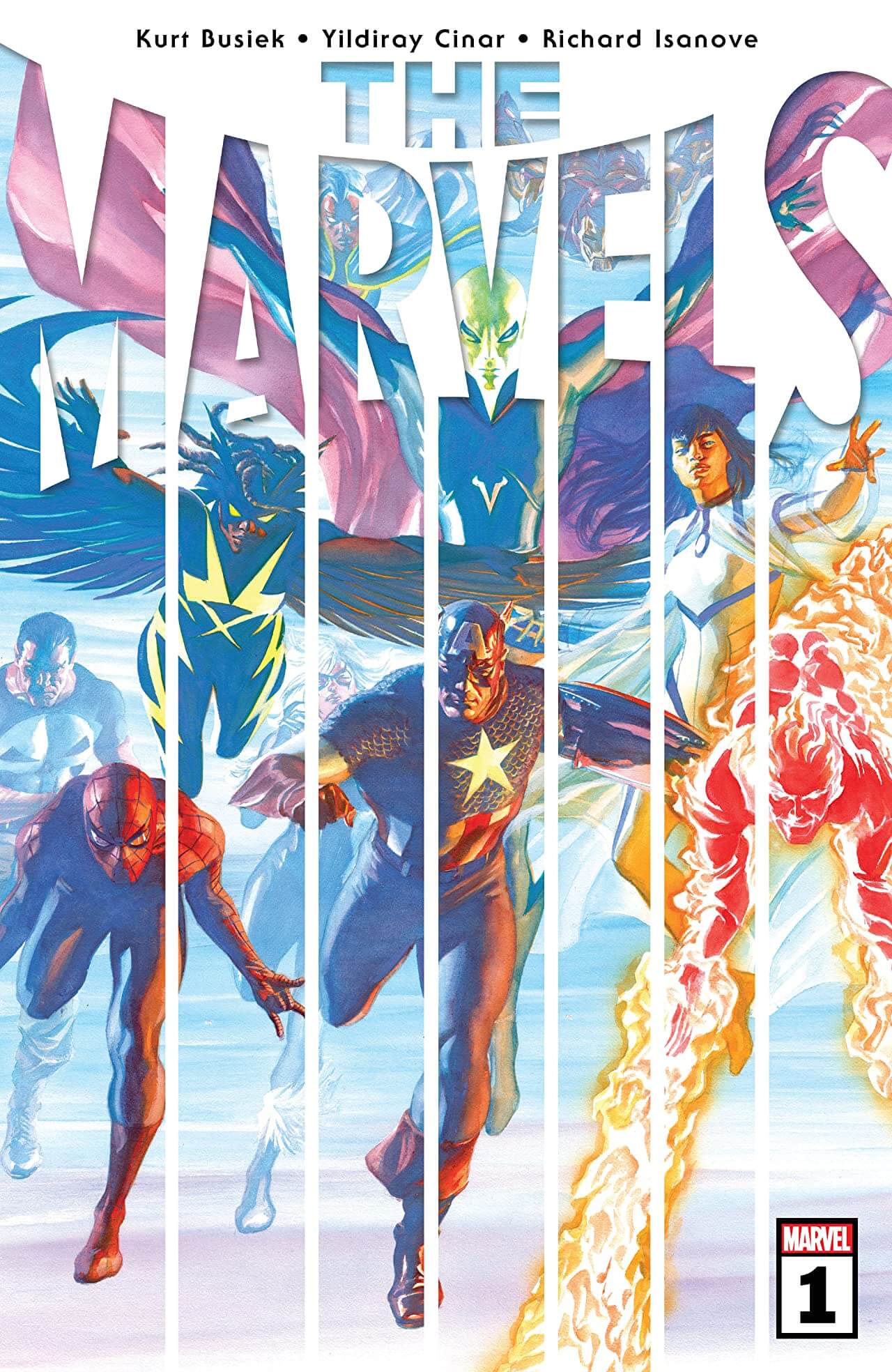Familiar heroes join new faces in The Marvels #1, as the world reels from the events of a long-ago war. When a villain with unknown motives arrives, the world’s greatest superheroes will have their work cut out for them. But are they up for the challenge?
The Marvels #1
Simon Bowland (Letters), Kurt Busiek (Writer), Yildiray Cinar (Artist), Richard Isanove (Colours)
Marvel Comics
April 28, 2021
If my vague introduction to The Marvels #1 has you wondering what this book is really about, join the club. I have no idea. I read all 37 pages of this opening issue, hoping the next page would clear things up, but that didn’t happen.
It doesn’t help that I thought I knew what I was getting into with this book. A few years ago, I read the Marvels miniseries from the 90s, also written by Kurt Busiek. I loved the series and always wondered if there would be more. Technically, this new series is a follow-up. But instead of seeing the Marvels, aka the superheroes, from an ordinary photographer’s point of view, this series focuses on the heroes. I don’t understand how that makes The Marvels #1 different from all the other superhero comic books on the stands. Aren’t they all told from the heroes’ points of view? The first half of this book read like any other comic, which had me even more confused as to why this series was being touted as a successor to Marvels. (Also, how is adding ‘the’ in front of a title a differentiator? I have the same issue with the upcoming Suicide Squad, I mean, The Suicide Squad. See what I mean?)
The concept of The Marvels #1, as explained by Busiek at the end of this book, is to show multiple characters in multiple places and timelines. “Anyone. Anywhere. Any time.” That sounds interesting, but I’m not sold on the execution, at all. The story starts off in 1947, then we see flashbacks within flashbacks. Then the book fast-forwards to the present and shows us various events happening concurrently. It is trying to be clever by subverting our expectations of linear storytelling. But to me, it felt like the book was being deliberately confusing. If I was simply befuddled, that would be fine. But I was annoyed. Because the time-jumping had nothing to do with the story. Could it impact the story in subsequent issues? It very well might. Will I be reading those issues to find out? No.
The time-jumping isn’t the only reason I couldn’t take to The Marvels #1. The setting is a mess. The book pins its narrative on the fictional Siancong War. In the new Marvel continuity, numerous heroes fought in the war, and it became an origin story for characters like Frank Castle/The Punisher. Instead of the many real wars that the Marvel comics could be diving into right now, they are hinging their bets on this fake and incredibly racist war. The WWAC team has already broken down why the concept of the Siancong War is problematic, so I won’t go into it here. Let’s just say this: it’s bad.
Even if you do not know anything about the Siancong War, the moment the book opens with a facsimile of Vietnam, you know The Marvels #1 is going down the wrong route. The effects of the Vietnam War can still be felt today. To use it as an aesthetic to tell a story? Not a good look. I hoped that the book would do the unexpected by giving readers the point of view of the Sin-Cong soldiers, as they are known here. We don’t get that either. We primarily see American point of view of the war. You’ve already lost me there.
To make matters worse, there aren’t many women in this book, nor are there many characters of colour. We get a glimpse of Storm, as well as two new characters of colour. They don’t get any dialogue. Captain Marvel chats with Steve Rogers about a sandwich. The two women of colour who do speak are Lady Lotus and a new character named Anna. Don’t get excited, because it is nothing good.
Lady Lotus is a character who first appeared the 1970s, and as one can imagine, the writing for her has not aged well. So, when Lady Lotus is introduced in The Marvels #1, her clothes in tatters in a highly sexualised way, I had to check the date on the book I was reading. This book may have been published in 2021, but it still treats Lady Lotus like it’s the 70s.
Not only do we get this inappropriate introduction to the character, but she’s immediately mistaken for a sex worker. Because that parallel with the treatment of Vietnamese women during the war just had to be included in this book, I guess? She is a woman in distress, and these men can’t see it or don’t want to see it, and we the readers are supposed to be okay with that? Then the book tries to paint her as the villain, and I’m like, no, I think I’m on her side, thank you very much.

We do see Lady Lotus in her glory days, dressed head to toe as a femme fatale. It looks like a hodgepodge of South-East Asian styles, which I guess Sin-Cong means to represent. But South-East Asia is huge and diverse with very different cultural motifs. Surely in 2021, we’re not still grouping them all together? Everything about Lady Lotus screams racism and misogyny, and I don’t know how this series will handle those issues, and the character, with the nuance they deserve.
As I mentioned, the other woman of colour in The Marvels #1 is Anna. We only get to meet Anna through her partner, Kevin Schumer, who I assume is the protagonist of this series. Anna at least gets to speak, but it is only in service of Kevin, which is not a great start. She does love her sandwiches (what is with this book and sandwiches?), which made me more interested in her than Kevin.
So, who is Kevin? This book keeps his story deliberately vague. According to Busiek, the next issue will shed some light on Kevin. They should have done that here because, in this book, Kevin does not come across as an interesting character. He’s a run-of-the-mill ordinary man in soon-to-be extraordinary circumstances. He conducts superhero tours of Manhattan for a company called Kshoom. That’s it. Nothing is recommending Kevin to the reader, but we are supposed to be excited about meeting him again throughout the series. I’m not feeling it.
While I was not a fan of the first half of The Marvels #1 because it jumped all over the place, the second half with Kevin and his tour was even more lackluster. I understand this section of the story is harkening back to Marvels and the ordinary man’s point of view, but Phil the photographer at least had an inner life that connected him to the audience. Kevin doesn’t have that. Plus, he’s boring. A straight white man’s point of view is not exactly hard to come by in comics.
I do like the art, though. Yildiray Cinar captures the pop art panache of classic Marvel Comics beautifully and makes the story’s settings come alive. There are so many details in the backgrounds, the costumes, the vehicles, and the characters. Every page is a joy to behold. I love that all the faces are distinct—there are no mixing-up characters here. And Richard Isanove’s colours are gorgeous. What a vast palette used to precision on every page.
But the cover by Alex Ross, the artist on the original Marvels, is breathtaking like a painting one would hang in a museum. I’d loved Ross’s art in Marvels, and I would have loved to see more of it here. As much as I enjoyed Cinar and Isanove’s work, there’s a disconnect between the cover and the inner pages that took me out of the experience.
As a fan of Marvels, I had high hopes for its follow-up. But The Marvels is too different. It tries to do too much, has a seriously problematic setting, and is plagued by unnecessary racist and misogynist moments. The art was beautiful, but it can’t save a disjointed story rooted in the past. I have no qualms about giving The Marvels a miss.



